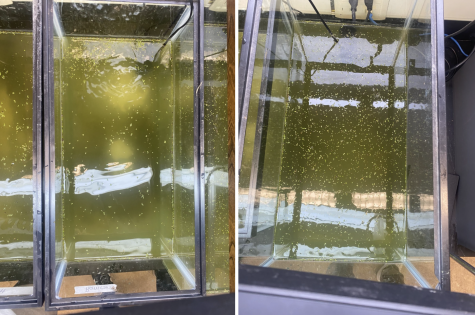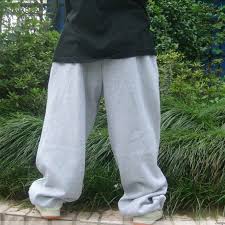Researching Poly Ponds
June 10, 2023
Over the past two months the Juniors in the Science Research course — a two year program — have been conducting their individualized projects, tackling the water quality issue on the Poly Prep campus. The class was divided into three different working groups: Field Work, Engineering, and Experimental.
The Field Work group’s research suggested that increases of carbonate in the ponds could be causing an increase in photosynthesis. This is harmful to the water because it meant that too much oxygen was being extracted, not leaving enough for the aquatic animals that live there.
The Experimental group used Gypsum in their project and their experiment suggested that Gypsum is able to provide a method of pond decontamination through 10-20 percent reductions in Salinity, Turbidity, and TDS. However, it also proved to be an effective stimulus for the growth of duckweed, a small, floating, aquatic plant.
Lastly, the Engineering group was able to build and produce a portable filtration system that pond water can pass through and ultimately reenter the pond with lower levels of nitrate and carbonate, overall improving the quality of water in the ponds.
All of this work began in the first semester of the school year when the whole class tested various contaminant levels in different water sources: including water fountains, the pond, and Commons drinking water. In the second semester, each group, using the previously collected data from the first semester, created projects and experiments that would attempt to further this research or perhaps find a solution to the problem.
The three groups each received a budget of $250 to purchase project materials and were given the opportunity to form their own service learning teams with students outside of their class, to assist in the project. Initial testing commenced when they surveyed the results of over 12 contaminants in the pond, with nitrate and carbonate providing the most prominent results.
Jess Dosik, Antonio DiNatale, and Mary Lin took on the field work project, in which they had to conduct extensive research and field work testing to figure out if Poly’s pond water is suitable for aquatic life. Originally, they tested for 16 different chemicals in both the pond’s waters, as well as samples from a koi fish tank and a hose in the greenhouse. In order to do this, they purchased testing strips that would test for each of these factors and used them every day to test the water in each of the designated locations.
Focusing on these five specific factors: hardness, alkalinity, nitrate, bromine, and carbonate, they generated tables and graphs based on the testing results which allowed them to see the relationship between the average concentration of each over time. Using these data tables and graphs, they also ran multiple statistical analyses in Microsoft Excel, called ANOVAs, which allowed them to determine whether or not the collected data was significant. In the end, the result of these tests all demonstrated clear statistical significance.
The most important findings were the nitrate levels in the hose, the carbonate levels in both ponds, and the bromine levels in the koi fish tank. The group hypothesized that the variation in both the hose and the koi fish tank data is due to lack of use in both water sources, as well as a suggestion of poor maintenance to the fish tank filters. However, the variation within the carbonate levels in both of the ponds suggests increases in algae and photosynthesizing materials, which is what leads to some of the harmful chemical levels in the pond.
Seanna Sankar, Hazel Budker, and Stephen Playford worked together in the experimental group where they filled four fish tanks of equal sizes (50cm x 25cm x 30cm) with 10 liters of water and dirt from the base of the pond to replicate the environment of the pond. Their project focused on maximizing light passage, or raising the turbidity levels. Gypsum, a water clarification agent, was added to two of the tanks (one from each pond) as they investigated whether the use of Gypsum would improve either water quality or turbidity. Once filled with water from the Poly Pond, the group introduced 50 ml of Gypsum to tanks three and four while maintaining one and two as controls.
Over the course of ten class periods, they collected data in the following variables: Temperature(℃), Total Dissolved Solids (ppm), Conductivity (µs/cm), Salinity (ppt), Turbidity (NTU). The group also performed an ANOVA on the resulting data to ascertain whether or not the introduced Gypsum had a significant effect on the water quality of each of the tanks.
In a second trial, they observed how duckweed, an aquatic plant that requires minimal care, would grow in the various conditions of the tanks. They set aside two groups of duckweed for incubation which would later be added to the tanks, and after three days, placed the same amount (100mL) of duckweed into the four tanks. They were able to track the duckweed growth by using photo analysis, which tracked the total surface area of the duckweed as an additive value of buds which appeared on the surface. These experiments suggested that Gypsum is effective for the growth of duckweed, as well as as a method of water decontamination.
Anjali Budhram, Danielle Jason, and Holden Pawlak were tasked with engineering a tangible prototype to aid the problem of cleaning Poly’s ponds. In previous research, the class had discovered the pond’s high nitrate and carbonate levels (unhealthy contaminants that were affecting the visual appearance of the pond as well as negatively affecting the aquatic life). The group went through various phases in deciding what form their prototype would take. Near the beginning of the project, they toyed with the idea of creating something similar to a Roomba to place on the floor of the pond to filter out nitrate and carbonate. They also inquired about ways to clean the pond with plants, such as water hyacinth and hornwort, that naturally lower contaminant levels and create a system to disperse the seeds throughout the pond. Finally, the three decided to create a portable filtration system that pond water could pass through and ultimately reenter the pond with lower levels of nitrate and carbonate.
Within the filter, there were various media, each chosen to filter out something different. The first layer is Biochar, which was chosen to filter out carbonate. It acts in a similar fashion to a magnet – since it has a negative charge, it is able to attract the positively charged cations within the water and adsorb carbonate. Since it also has such a large surface area (~330 m2/g), Biochar is optimal for filtration. The next two layers the water would pass through are lava rocks, to filter out nitrate, and aquarium filter media, a mesh used in many fish tanks, to filter out bacteria and larger pieces of debris (like leaves) that may have entered the filter. These three layers will then repeat, to ensure clarity of the water that goes back into the pond.
Recently, each group presented their findings to the Poly community through a science research symposium. Together, the science research students hope to apply their findings to the ponds at a larger scale in order to promote change in the Poly ponds.






























